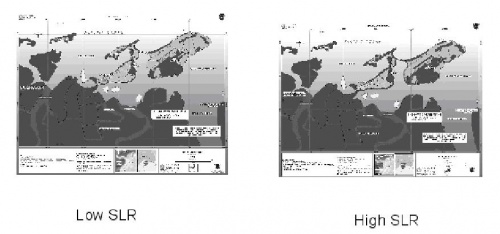San Andreas de Tumaco Vulnerability Assessment
Natural Susceptibility of San Andres de Tumaco
Mangrove ecosystems in Tumaco face major pressures that make them susceptible, diminishing their capacity to adapt to potential impacts caused by climatic events. The lack of local measures and planned management to conserve these ecosystems make degradation processes that affect their susceptibility more difficult to control. This situation is particularly alarming close to Tumaco’s urban area, where mangrove ecosystems face pressures from urbanization, direct exploitation and generally low environmental quality due to waste water disposal in the area. In general terms, it is estimated that mangroves have a medium level of overall susceptibility. For beach ecosystems, the lack of available information complicated their susceptibility assessment in Tumaco. Nonetheless, considering that the daily tide variation contributes towards building the response capacity of these ecosystems, the overall susceptibility of beaches is estimated at medium-low to medium level.
Socio-economic Vulnerability of San Andres de Tumaco
Although the results show significant differences in life conditions between the urban and rural areas, the overall socio-economic vulnerability for both is estimated at medium-high to high level. In the Tumaco and Visiosa Islands over half of the secure areas have high vulnerability. Also, Miramar urbanization presents very high vulnerability to SLR. On the Island of El Morro, most of the secure areas show a medium-high level of vulnerability, while the secure areas of the continental area of Tumaco have a high level vulnerability to SLR. Concerning the rural coastal area of Tumaco, 48.4% of the area exhibits a high level of vulnerability and 22.6% a medium-high level of vulnerability.
2019 Scenarios for San Andres de Tumaco
The scenarios described hereafter do not assume to predict what will happen, but are merely descriptions of different possibilities the study areas may face according to their present situation and the way local governments are planning their future development. Scenarios are placed in the year 2019, when the National Vision is to be fulfilled by the present administration.
Ecosystem quality will be enhanced as a result of the establishment of protected areas and the teaching of the population about the need to conserve these ecosystems. This means that although total ecosystem coverage might not increase, due mainly to land conversion for urban and agricultural expansion, ecosystem degradation will be reduced due to a more sustainable use of the natural resources. Moreover, the improvement in waste disposal and sanitary systems and agricultural practices will reduce the pollutants affecting ecosystem quality such as water quality and maintain the integrity of hydrographic processes. Therefore, although population growth may exacerbate domestic and agricultural activities, these activities will not affect the susceptibility of natural ecosystems. The overall susceptibility of Tumaco’s natural systems will remain the same. Moreover, the increase in both the rural and urban populations’ quality of life compared to the current state will contribute to decrease the overall socio-economic vulnerability in 2019.

San Andres de Tumaco: SLR levels for 2019 scenario development
2019 Scenario and sea level rise
Adding to this scenario the effects of a potential low and high SLR, it is possible to see that given Tumaco’s topography and local conditions (tide regime and other oceanic dynamics) both SLR levels will affect the entire area covered by mangroves and beaches. Nevertheless, Tumaco would have enough space to allow for migration of most of these ecosystems if local regulations were implemented to stop the construction of potential barriers. As a result, the overall natural susceptibility of Tumaco is estimated to remain at a medium level for mangroves and beaches.
Moreover, the estimations reveal that with SLR the islands have lower socio-economic vulnerability to flooding compared to the continental area. This is because the infrastructure of the islands is built considering a potential increase in the sea-level, while in the continental area the infrastructure is built without taking into consideration any preventive measures. In general terms, a medium level of socio-economic vulnerability is estimated for the urban area in Tumaco. The impacts of a high SLR are similar but larger in magnitude. While a low SLR would affect a total of 41,734 people, a total of 50,159 persons would be affected by a high SLR in 2019.
Back To:
Methodology of Colombia NCAP Project
Key findings from Colombia NCAP Project
On To:
(0) Comments
There is no content